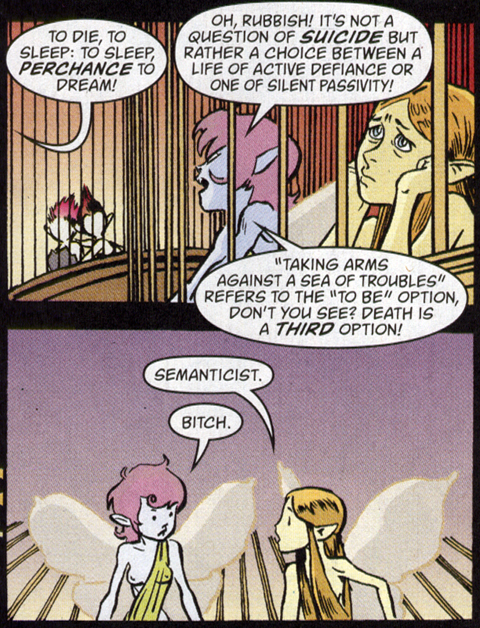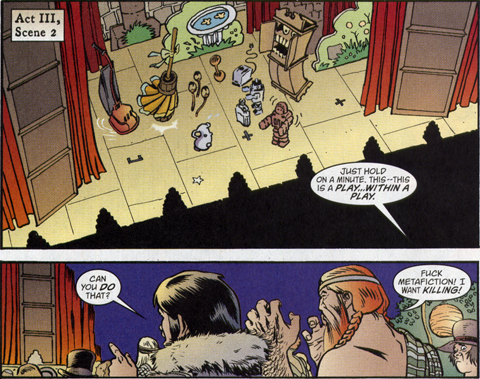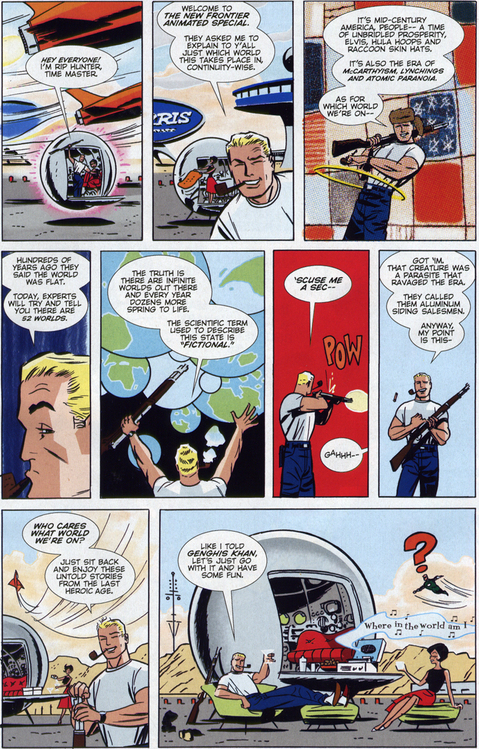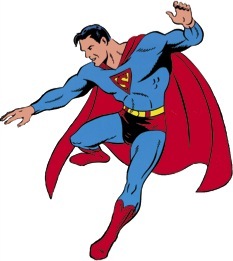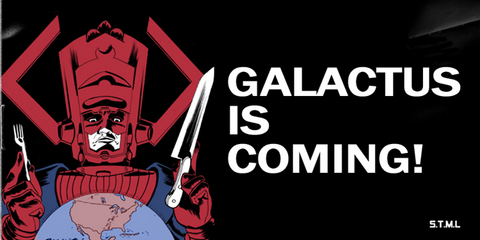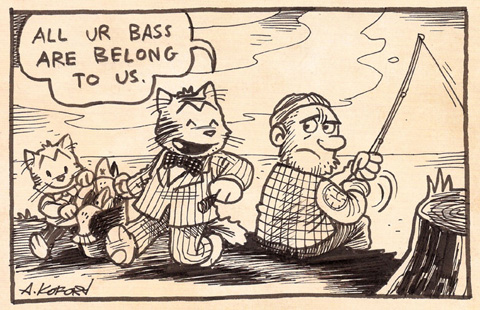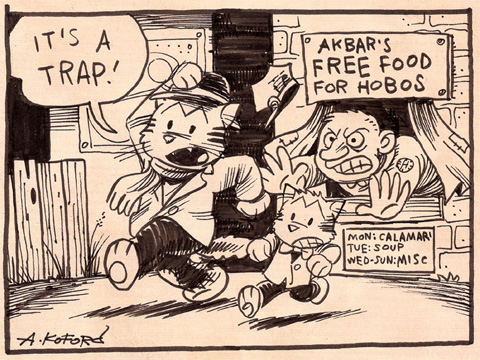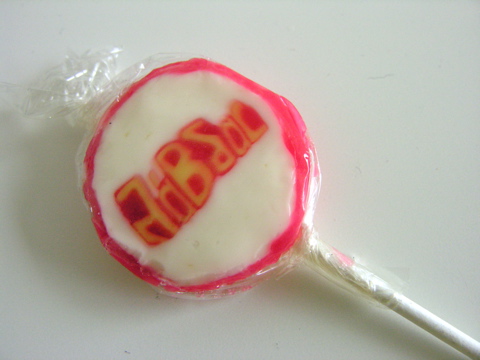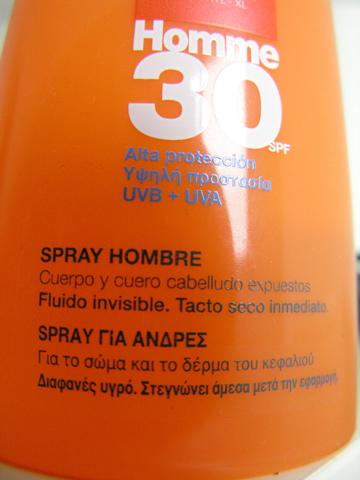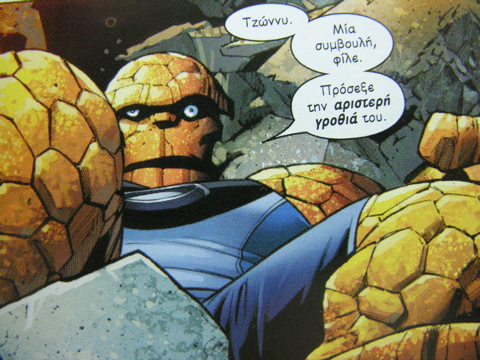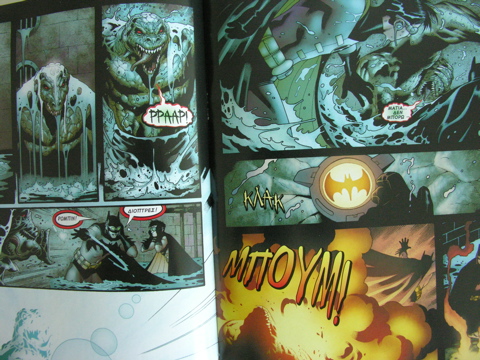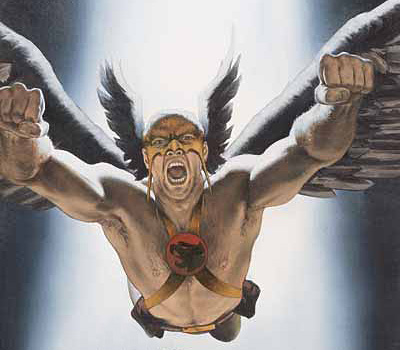Brace yourselves, gang, I’m about to geek out way beyond any geekery you’ve seen here yet. Today I’m going to meld together comic geekery and typographic geekery, and it’s not going to be pretty.
I’ve been meaning to rant for a while now about the general crappiness of the electronic lettering used in comics nowadays, which not only sucks all the charm out of traditional hand-lettering, but also leaves the lettering prey to all the mistakes of novice desktop publishers. This started when I kept noticing a simple typesetting error showing up over and over again in dialogue balloons: the use of a double hyphen instead of a proper em dash (– instead of —), a typewriter convention that spills over into amateurish handling of type. In digging up old samples to prove my point, however, I discovered that this was going on way before electronic lettering. Here’s a panel from 1966’s Fantastic Four #47:
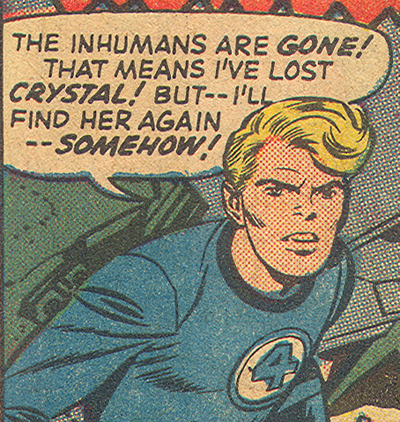
OK, so I guess this particular flub has been going on for a while, probably because traditional letterers were of a similar ilk as their modern peers: neither editors nor real typesetters, either of whom ought to notice things like that. Fine, I’ll let that slide. In the meantime, though, take a gander at the warmth and charm of that lettering. You know why it looks like handwriting? Because each instance of each letter is unique. Simple hand-lettering was cheaper and easier than typesetting, so it made sense, and the crudeness was an appropriate visual match to the artwork and the shortcomings of the reproduction. A perfect unity of tone.
So let’s look at today’s electronic lettering, which is trying to copy the effect of old comics but getting it all wrong. I’ll let this month’s Ultimate Fantastic Four #26 be my scapegoat:
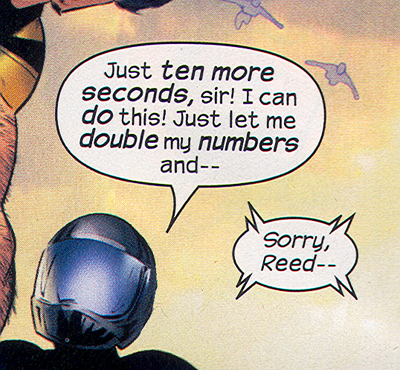
Yeah, that em dash thing. But I said I’d let that slide. Notice how every repeated letter is exactly the same? That, my friends, is why shitty handwriting fonts do not look like handwriting. They look like novelty typefaces. No variation, no warmth, no charm. It’s especially bad form when you get double letters or stacked letters. (Look at “do” and “double” up there.) It’s an affectation, but only taken halfway. Now, I’m not saying modern comics with their detailed art and magnificent reproduction quality should switch to real typefaces. If that happened legions of fanboys, myself included, would probably have massive aneurisms all at once. But since they’re not paying someone to do all that lettering by hand, couldn’t they invest in some better fonts? Some fonts that do a better job of faking the craftsmanship they’re trying to ape? That stuff doesn’t even come with decent letterspacing built in, never mind alternate characters. Gentlemen, we have the technology!
OK, but that’s not even what hurts the worst. Let’s turn our attention back to FF #47, paying a visit to the letter column this time:
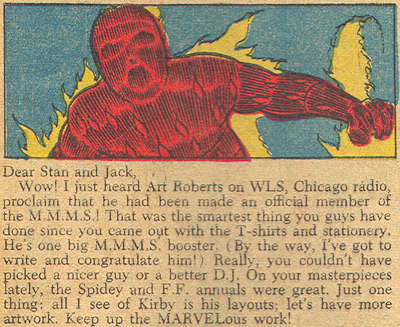
Now, that’s not the best typesetting in the world, but it’s good for what it needs to do. A nice, wide serif typeface that can handle the cruddy printing, and some attention to details like indents, justification, and even ligatures. (Look at the “ffi” in the word “official” — that’s what real typefaces do when they’re used properly, kids.) Since they’re using real type, they’re using good type. Hallelujah!
Ultimate Fantastic Four, however — like most of its contemporaries — makes the Baby Jesus cry:
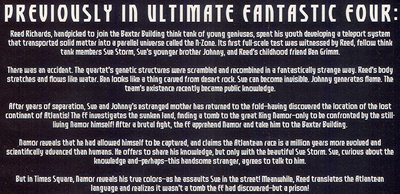
How to make my eyes bleed, step 1: pick a goofy, “techy” novelty font that ought to be used — and sparingly, one would hope — for titles only, and set paragraphs of text with it. Step 2: set it in white on a black background with no extra letterspacing. Step 3: make sure the line length is super-long and the line spacing is super-tight, so that it’s even harder to read easily. Step 4: center those lines, just to put the rotten cherry on top of the whole thing. Also, those horrible little em dashes that almost look like hyphens, and with no extra room around them! That is not what I want to decipher at the end of a long day.
Now, the thing that pushed me over the edge and made me finally rant like this was actually this image of the Daily Bugle taken from this month’s Daredevil #80 (which otherwise has artwork that’s totally white-hot):

Goddamn, could that look any less like the page of a newspaper? And they pull this crap all the time in Daredevil. (I’m afraid to even look at The Pulse, which probably does a little bit in every issue.) Let me enumerate the sins. Problem 1: there are at least 5 different typefaces in use, and none of them would be really good for newspaper. And they shouldn’t ever get used at the same time (Helvetica and Verdana, I’m looking at you!) Even if they were, there would be 2, maybe 3, altogether. Tops. Problem 2: either the Bugle is a letter-sized pamphlet, or that’s the large-print edition. Three columns, with about 35 characters to a line? I call bullshit. Problem 3: Sometimes the paragraphs are flush left, sometimes they’re justified. Sometimes only half the paragraph is flush left but the rest is justified. (That means that someone used a hard return to make a line break mid-paragraph, which is just bad form.) Problem 4: those paragraph indents are word spaces, not proper em spaces or decent-sized tab stops. that’s why it’s kinda hard to see where each paragraph starts. I spend obscene amounts of money each month for this?
Dear Marvel, please give me a dream job as a typography director so I can make you look better and make the world a more better place. And don’t get cocky, DC: you’re next in my sights.
